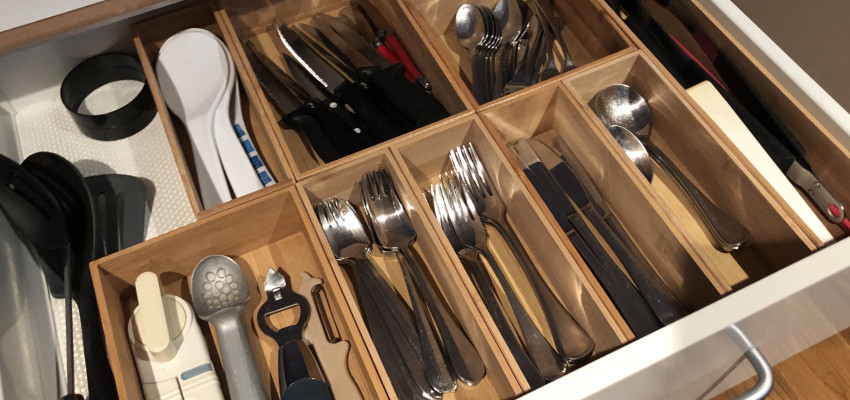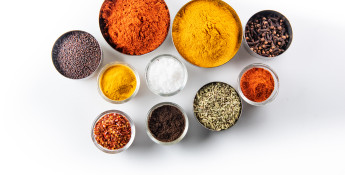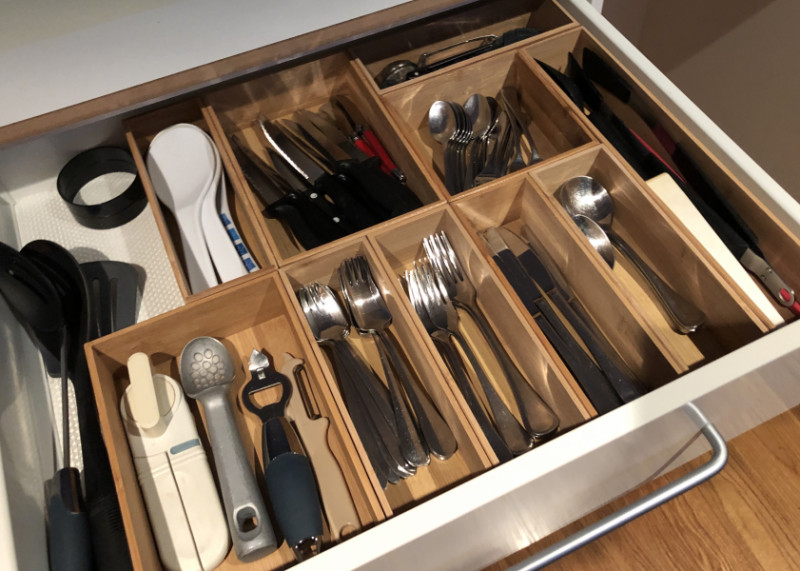By Chef Alli on July 29, 2021
Staying Safe in the Kitchen

Accidents are bound to happen in the kitchen. With sharp knives, high heat and moving beaters, things can get dicey.
Understanding potential kitchen hazards can help you and your family avoid cuts, burns and even food poisoning. Below are some kitchen tips to help keep you safe.
Never Set a Hot Glass Dish on a Cold or Wet Surface
Because glass expands when it gets hot and then shrinks as it cools down, the stress can result in a combustion of glass. The best place to rest a glass dish or lid is always a cutting board, trivet or thick potholder.
Cover Hot Handles
As the cook, you realize the skillet handle is hot, but those walking into the kitchen do not. If they reach for the handle to lift or move the skillet, their hand can be badly burned.
And, if they drop a heavy skillet full of food, it can easily crack a countertop. Food that splatters from this drop would also likely cause bodily harm.
Another good option for keeping a hot handle safe is by placing a silicone cover over it. These come in various sizes to accommodate different widths and lengths of skillet handles.
Be Careful Where You Use Your Cast Iron Cookware
When cast iron cookware is created, it often has exterior areas that are uneven, creating dangerous heat pockets beneath the pan. These heat pockets will not hurt your cast iron skillet, but they sure can damage your smooth-top ceramic range.
Instead, use enamel-coated cast iron when cooking on a smooth-top range. The enamel coating fills in any uneven areas on the natural cast iron, making it perfectly smooth and safe for cooking on an electric-ceramic range.
Practice Safe Oven Storage
Do not use your oven for storing anything other than oven-proof cookware. It is far too easy to preheat an oven without thinking to look inside first.
I once melted an entire oven full of large Tupperware containers at a client’s home because I didn’t check inside the oven before preheating. It was an awful mess and one I’ll never forget.
Sponge Safety
Kitchen sponges are notorious for gathering harmful pathogens very quickly.
To keep your kitchen sponge safe and sanitary, wet it down well with clear water, then wring it out. Next, place the wet sponge flat on the microwave turn table. Microwave the sponge at full power for 30 seconds.
Let the sponge fully cool before removing it from the microwave, then let it air dry. Repeat this process every one to two days to keep your sponge safe and germ-free. If a microwave is not available, kitchen sponges can also be boiled for five minutes.
Keep Your Kitchen Sink Sanitized
Did you realize the drain of your kitchen sink typically harbors more than 18,000 bacteria per square inch? No wonder studies show the kitchen sink boasts more bacteria than the garbage bin.
Hot, soapy water is effective at eliminating bacteria, but for added insurance, clean your kitchen sink and surrounding areas frequently with a hot solution of 1 tablespoon bleach per quart of water.
This would be a good time to sanitize the stove knobs and the salt and pepper shakers.
Change Out Kitchen Towels Daily
Kitchen towels may not show it, but they are very often loaded with germs. A kitchen towel can be easily grabbed and used for many jobs it was not intended for.
Wet but not-exactly-clean hands can be wiped on it. And what about greasy hands?
Or what if your back is turned and one of your kids uses it to wipe up a spill in the floor? Change out that kitchen towel often.
Hand Towels vs Dish Towels
Growing up, my mom always kept her kitchen hand towel separate from the kitchen dish towel.
As a kid, I thought this was completely ridiculous. Now that I’m an adult, I think it’s brilliant and necessary. A hand towel is very often loaded with germs and should not be used for wiping clean dishes.
Never Use a Damp Kitchen Towel as a Hot Pad
This is one of the quickest ways to get burned in the kitchen. Many of us have a kitchen towel on our person when we are cooking. I personally like to keep one at my waist since this keeps it in quick reach of my hands.
In a hurry, I’ve caught myself grabbing that kitchen towel to use as a hot pad only to have to jerk my hand back in regret. When a damp kitchen towel cozies up to a hot pan or baking dish, the heat can send hot steam over the surface of your hand. Ouch.
Always Wear Safe Attire When Cooking
Long loose sleeves and baggy blouses are begging to catch fire, plus it’s unsanitary if clothing happens to drag through foods cooking on the stove.
Wear short-sleeve or fitted long-sleeved tops. Also, as an extra precaution, never wear any type of flammable clothing when cooking, since these fabrics can ignite and melt.
Wear Shoes in the Kitchen
It’s not exactly comfy and cozy but think how you’ll feel about your favorite slippers if you drop a knife into the top of your foot.
Wearing shoes when we cook will also protect us from other kitchen mishaps such as broken glass, boiling hot water and hot oil spills.
Employ a Sturdy Step Stool
Falls in the kitchen are quite common. In a hurry, we may use an unstable kitchen chair when we try to reach for something.
Having a sturdy and handy step stool is not only safer but can also help use more of that hard-to-reach cupboard space.
Keep a First Aid Kit on Hand
A well-stocked first aid kit in your kitchen or pantry is essential, just as making sure everyone at home knows exactly where it’s located.
Acquainting ourselves with the kit before an emergency happens helps us learn what we have available in case of injury.
Learn How to Extinguish a Fire
More than 150,000 residential fires happen each year and they almost always start in the kitchen, making cooking the leading cause of injuries occurring in our homes.
A fire extinguisher is the most essential appliance in our kitchen, even though we may never have to use it.
Because it only takes seconds for a grease fire to get out of hand, it’s important to know how your extinguisher operates. Store your fire extinguisher in an area close to your stove top, and make sure everyone at home knows where it’s located and how to use it.
Most local fire departments are happy to provide fire extinguisher advice. Because fire extinguishers have inspection dates that expire, your local fire department will also be glad to help you keep it up to date and operating properly.
More Kitchen Fire Precautions
Never attempt to put out any kitchen grease fire with water. The water will only fan the flames, spreading it even further. Instead use flour, baking soda, a lid or cookie sheet to extinguish flames by smothering them. Suffocating a cooking fire by removing air is the best way to put it out.
Be careful when using deep-fat fryers. Make certain the electrical cord is safely tucked up on the counter, never dangling where small children or pets could pull them down.
A fire inside your oven is best put out with an extinguisher; a microwave fire can be extinguished simply by turning off the appliance (or unplugging it) and keeping the door closed.
Test smoke detectors quarterly to be sure they are in safe, working order.
Organize Utensil Drawers
We all have a utensil drawer or two filled with all kinds of tools and sharp objects.
Trying to keep our utensil drawers organized in the same, consistent way is helpful so everybody can know what to expect when they use it.
For example, if everyone using the utensil drawer knows that the knives are always on the left in the drawer, they won’t be reaching over to that area when they need a spoon or a whisk.
If the utensils are just randomly cluttered in a drawer, it presents greater opportunity for injury.
Knife Storage
Knives pose a hazard in the kitchen, especially if they aren’t stored properly.
If knives must be stored in a utensil drawer, place them so the tips are pointing toward the back of the utensil drawer, so nobody gets poked as they reach in. Place the knives so they are all together in one place in the drawer, making sure the sharp edges are all directed down in the same way.
Protective covers are good for knives that must be stored in a utensil drawer. Covers can be as simple as a cardboard paper towel roll that is flattened and made into a knife sheath. Color code with different colors of duct tape for added strength and fun.
If you are storing your knives in a knife block, place them into the block with the sharp edge of the blades pointed up. This may seem odd, but it really helps to preserve the sharpness of the blades since the knives are then resting on their spines when not in use, instead of the blade.
Household Chemicals
Many of us store cleaning supplies and insecticides in the kitchen, typically beneath the sink.
This places potentially dangerous household chemicals within easy reach of children and pets. Many cleaning products are harmful or fatal if ingested, and can also cause burns, skin irritation and other problems.
Install safety locks on the doors of cabinets where potentially dangerous chemicals and cleaning supplies are stored. Always store bleach and ammonia in separate areas; they can produce a dangerous reaction if they come in contact with one another.
Post the number for poison control on your refrigerator or inside a cabinet door in case of emergency situations.





